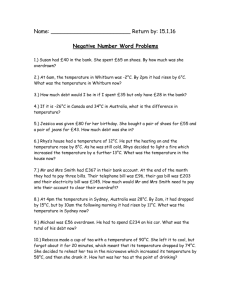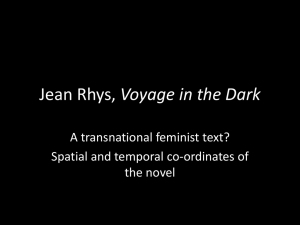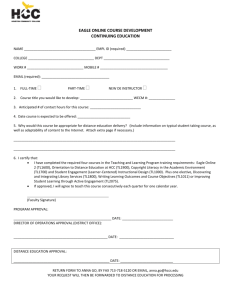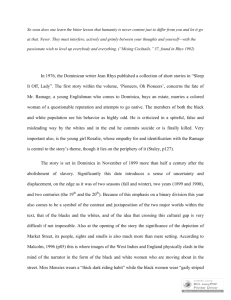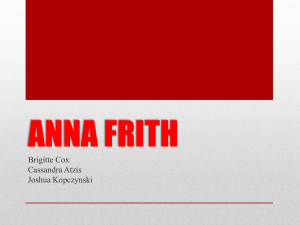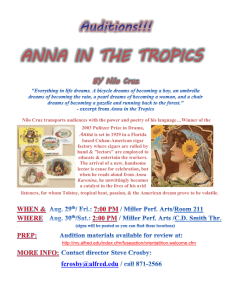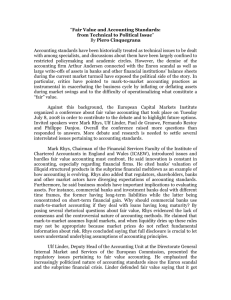Jean Rhys Voyage in the Dark A Transnational Feminist Text?
advertisement
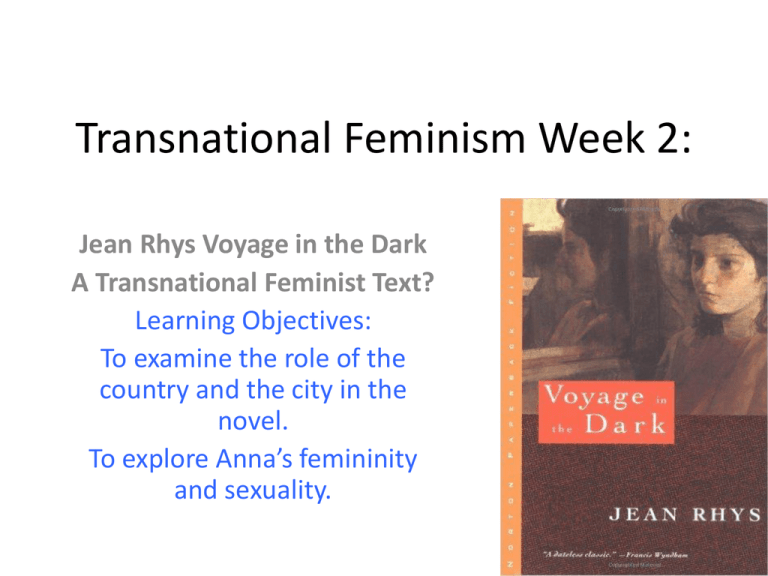
Transnational Feminism Week 2: Jean Rhys Voyage in the Dark A Transnational Feminist Text? Learning Objectives: To examine the role of the country and the city in the novel. To explore Anna’s femininity and sexuality. Notices • The exam is unseen. • Essay questions online will be altered. • Use of Facebook - Ellen Bibi – Each member of the seminar should sign up for one week in each term where they will be responsible for curating discussion. This means that you are expected to post an article, a film clip, an image or a point of discussion for the week you have signed up for. All others should make sure that you respond to a post on Facebook at least 3 times during the term. • Course of interest – http://www2.warwick.ac.uk/study/cll/courses/short/certifi cates/feminism_literature_and_censorship/ Book online soon to join. The Country and the City • Raymond Williams famously notes the peculiar slowness with which British literature came to appreciate the urban landscape “even after society was predominantly urban its literature, for a generation, was still predominantly rural” (2). • What role does London play in Jean Rhys’s novel? London at the turn of the 20th c • Capital city/World city • Capital in both senses of the world: Pre-eminent city of England; centre of capital its wealth and grandeur created by the Industrial Revolution, but also crucially by its colonies (plantations in the Caribbean, colonization of India and Africa) brought amazing amounts of wealth to the capital city The city as a concentric circle • Within a geometric imagination, the city is figured as a series of concentric circles. In the inner circle, the masculine sphere constitutes the center of power in the city, with the women at the periphery. • In the global sphere, the European city constitutes the core of the empire, its colonies the periphery. • How can we relate this to Anna’s position in the city? • How is her position in the city influenced by her family’s colonial estate? • Where would you place her within the concentric circle? The Ruined Estate • Like Rhys, Anna’s estate was already in ruins before she was born, but she refers to the ruins of the estate throughout the novel – can you find some examples? • “I’m a real West Indian… I’m the fifth generation on my mother’s side” (55). Why does Anna insist on proclaiming her loyalty to a landed family history when she has only ever seen the estate in ruins? Identity Formation • What impact does the destruction of her family estate have on Anna’s identity formation? • Why is it so important to her identity and sense of place? Does Anna belong in the colonies or Europe? • Eric Johnson poses the question that most critics would agree is the source of conflict for Rhys’s troubled heroine: “Did the child of European background, born and raised in the colonies, ‘belong’ in the land of her birth – in which case home was lost upon her repatriation to metropolitan Europe? Or did she belong in the unfamiliar reaches of Europe – in which case she could only desire a sense of belonging unavailable to her in the land of her birth?” (17). Gendering the City • The Flâneur: a stroller, a man of leisure in the city (idler), a dandy, an urban explorer. A literary type in French literature, viz. poetry of Charles Baudelaire (18211867). Theorised in the work of Walter Benjamin, as the quintessential figure of modern/ist capitalism. • Can you find some examples of a Flâneur in the novel? Walking/Mapping/Self-fashioning • Rhys’s representation of female labour in the city, or women’s work more generally, provides a critical counterpoint to the capitalist arrangements that underpinned the modernist city. While the flaneur, the man about town, embodied modernist anxieties about intellectual labour (elaborated through a veritable elision of domestic and sexual labour), the labour of fashioning oneself as a modern subject in the city is gendered. • Working-class women involved in increasingly alienated sexual labour in the service of the capitalist urban machine. Oiling this machine are men with new money, engaged in city-based transnational transactions that operate alongside, if not entirely depend on, the traffic in the underclass of women. • How does Rhys present women’s work in the city compared to the men about town? • How would you position Anna's sexual, economic and ultimately political body within the spaces of London? Anna’s Mobility • Is it important that Anna is repeatedly asked to leave the homes she briefly inhabits? • How can we read the fact that Anna Morgan keeps moving? • What does her mobility teach us about the nexus between gender, home and national identity? • Find some evidence from the text to support your responses. Improperly Feminine • Anna’s mobility is not the only aspect of her character that marks her as improperly feminine, what else conflicts with the ideological work of home? • Find some examples to support your responses. Anna’s Femininity • Jane Garrity in Step-Daughters of England: British Women Modernists and the National Imaginary. New York: Manchester UP, 2003 explains the policing of female sexuality has long served the interests of the nation-state in general and the British Empire specifically: • “British women were viewed primarily as mothers, not daughters in the eyes of the State. Valued for their role as reproductive conduits, white Englishwomen’s bodies were subjected to a variety of regulatory practices that sought to construct them, physically as well as spiritually, as potential mothers of the British race. Chiefly valued as national assets because they could bear healthy white citizens, these select Englishwomen would both stabilize the imaginary borders of the nation and contribute to the expansion of it empire” (1). • How would you interpret/define Anna’s femininity in light of this? Jean Rhys, a transnational biography Rhys • Rhys’s biography (personal and writerly) is transnational: • In 1907, at the age of sixteen, Rhys left her family in the Caribbean and arrived in England. She spent the years leading up to World War I and the subsequent wartime years in London, returning to the city again after spending the decade of the 1920s in Paris. • She was of mixed national heritage as a white creole from Dominica, itself a hybrid, multi-layered place with its own history of multiple colonizations and diasporic movements. Secured by the British in 1805, the influence of French culture on Dominica remained such that the African-Caribbean majority spoke a French patois. • Here Rhys was part of a small Protestant elite in a majority Catholic culture. She went to a Catholic school where whites were in a minority. • The daughter of a Welsh father (whose own mother was Irish), Rhys referred to her cultural origins as “pseudo-English” in her memoir Smile Please. Hottentot Venus • Perhaps as an extension of this, Rhys also occupied an ambiguous place within the racial and sexual demarcations of the imperial metropolis. • Views of the Caribbean in the metropole associated it with degeneracy, vulgarity, sexual immorality, illegitimacy, as a resolutely “unEnglish kind of place”. In particular, white creole women, the West Indian heiresses, were likened to the figure of the Hottentot Venus, a nineteenth century racialized vernacular image for pathologically sexualized women. • The most celebrated literary example of a white creole woman who meets a tragic fate is of course the crazed Bertha of Charlotte Bronte’s Jane Eyre— violent, bestial, degenerate and transgressive of Victorian codes of femininity and domesticity. How would you describe Anna’s racial and sexual position within the imperial metropolis? Liminal Rhys • Rhys continually contests boundaries of identity, nation and culture. • In her memoir, Smile Please, Rhys represents herself as an alienated and reviled stranger in the imperial heartland; other fellow writers and critics have echoed those views. • Taking their cue from Rhys’s own ambivalent pronouncements about her origins, critics like Helen Carr point out that “as a white creole from Dominica she was ‘West Indian’ in a different way…” Kenneth Ramchand writes of the historical predicament of the white creole as consisting of a “terrified consciousness” emanating from a sense of belonging to nowhere. Judith Kegan Gardiner notes that "on both sides of the Atlantic (Rhys) felt in the position of a member of a racial minority living among a resentful majority", a fact that led Rhys to continually contest boundaries of identity, nation and culture. Black or White • Critics have picked up on this pervasive mood of estrangement from the colonial metropole and have read Rhys as a black writer, though it is unclear how satisfied she would have been with such a classification. • Such a critical move is complicated by the fact that as a white descendant of slave-owners, the West Indies could never be home, in either a moral or an existential sense, for Rhys. • Nevertheless, Rhys’s readability as a black writer only underscores her troubled relationship to metropolitan modernity. Rhys has thus emerged in Anglophone modernist literary history as the quintessential outsider figure. In particular, her female protagonists embody this sense of being outside class, race and nationality assignations. Thus the woman on the edge of modernist urbanism was to become a defining figure of resistance in Rhys’s fiction. • Do you consider the novel to be a transnational feminist text? Further Discussion Questions: 1. How does Anna view London and England? Find some examples from the text to support your responses. 2. Does Anna self-fashion her own identity over the course of the novel? 3. What colours are used in the novel to represent the West Indies and what colours represent England? Find some examples. What does this tell us? 4. Voyage in the Dark was originally called ‘Two Tunes’, what does this tell us about the novel and its meaning? Further Discussion Questions 1. How does Rhys portray Anna’s experience of romance and love? 2. In the original Anna dies, how would this ending have changed the novel had the editor not insisted on it being revised? 3. How do you interpret the use of first person narrative in the text? 4. What does Anna represent?
